Maintaining proper tire pressure is essential for the safety, performance, and peace of mind of recreational vehicle (RV) drivers. An RV tire pressure monitoring system (TPMS) is an affordable and effective way to ensure that your tires are always at the optimal pressure levels. These systems provide real-time monitoring of tire pressure and temperature, so you can detect potential problems before they lead to accidents or tire failure.
Whether you’re a seasoned RVer or just starting out, a TPMS for RV can be a valuable tool for keeping your tires properly inflated and ensuring your safety on the road. A good TPMS will provide you with accurate tire pressure information, so you can catch any problems early on and avoid potential accidents. It can also help you improve your fuel efficiency and extend the life of your tires.
If you own an RV, I highly recommend investing in a TPMS. With so many RV TPMS options on the market, it can be tough to find the perfect one for your needs. In this guide, we’ll explore some of the best RV tire pressure monitoring systems on the market and help you choose the right one for your RV.
Let’s join forces as I review and compare the top TPMS options to help you make an informed decision and enjoy worry-free travels with your RV. If you’re new to this, don’t fret. I’ll also share with you everything you need to know about TPMS for RVs.
Contents
- What is an RV Tire Pressure Monitoring System?
- How Does a TPMS for RV Work?
- Why Are TPMS Systems Important for RV?
- What Are Different Types of TPMS for RV?
- Best RV Tire Pressure Monitoring Systems: In-depth Reviews
- Choosing Tire Pressure Monitoring System for RV: Buying Criteria
- Who Makes The Best RV Tire Pressure Monitoring Systems?
- How to Install an RV Tire Pressure Monitoring System
- FAQs about TPMS for RV
What is an RV Tire Pressure Monitoring System?
An RV tire pressure monitoring system (TPMS) is an advanced electronic device that monitors the air pressure and temperature of the tires on a recreational vehicle (RV) or motorhome in real time.
It consists of three main components:
- Sensors: These are small devices that are installed on each tire. They measure the air pressure and temperature in the tire and send this information to the monitor.
- Monitor: This is the device that displays the air pressure and temperature information from the sensors. It may also have a built-in alarm that sounds if a tire is low on pressure.
- Wireless communication system: This system connects the sensors to the monitor. It can be a radio frequency (RF) system or a Bluetooth system.
Direct TPMS provides the actual air pressure in each tire. Some sensors can even measure the temperature inside the tires and alert you of fast or slow leaks. This type of TPMS is a more popular option for RVers because it is more accurate and reliable
Indirect TPMS, on the other hand, only alerts you whenever one or more tires of your RV are underinflated or overinflated. It does this by monitoring the wheel speed and calculating the air pressure based on that information. Indirect TPMS is easier to install and maintain, making it a good option for those who are looking for a more affordable and convenient solution.
Some advanced TPMS systems also provide alerts or warnings if the tire pressure drops below or rises above a preset threshold, or if the tire temperature exceeds a safe range.
Depending on the type of TPMS you have, the information about your RV tires is displayed in real time, either as numbers on the monitor screen, a gauge clock, or just a warning light. Both types of TPMS can be useful and provide peace of mind to RV owners by allowing them to easily monitor tire conditions and proactively address any issues that arise.

How Does a TPMS for RV Work?
TPMS is a sophisticated technology that ensures the safety and performance of RV tires by continuously monitoring air pressure and temperature. It consists of three main components: tire sensors, wireless communication, and a display unit, working seamlessly to provide real-time insights to the driver.
Once activated, the TPMS sensors in each tire start measuring the air pressure and temperature. The sensors use pressure transducers to measure the air pressure, and temperature sensors to monitor the tire’s temperature and its surrounding environment. The collected data is then wirelessly transmitted from the sensors to a central display unit using technologies like Bluetooth, radio frequency (RF), or other proprietary wireless protocols.
The display unit receives the data and processes it in real time, converting the sensor readings into understandable pressure and temperature values. This processed data is then compared to pre-set thresholds that define acceptable pressure and temperature ranges for each tire. If any tire’s pressure or temperature deviates beyond these thresholds, the TPMS generates alerts to notify the driver of the anomaly.
TPMS alerts can come in different forms, such as visual notifications on the display unit’s screen or audible alarms that grab the driver’s attention. Some advanced systems can even integrate with smartphone apps to send notifications directly to the driver’s mobile device. This immediate alert system ensures that drivers are promptly informed of any potential tire-related issues.
Through the user-friendly interface of the display unit, the driver can access real-time tire data for each individual tire. This includes information about pressure levels, temperature, and the overall status of all tires. Many TPMS systems offer customization options, allowing drivers to set their preferred pressure thresholds and temperature alerts based on their RV’s specific requirements and their personal preferences.
The TPMS is designed to provide continuous monitoring of tire conditions while the RV is in motion. As the RV travels, the TPMS receives updated data from the sensors, allowing it to identify any changes in pressure or temperature that may occur during the journey. This proactive approach empowers drivers to take immediate action to address any deviations from the recommended tire conditions, thereby preventing potential tire blowouts, uneven wear, and accidents caused by tire-related issues.
Why Are TPMS Systems Important for RV?
RVs are large and heavy vehicles that put a lot of stress on their tires. They’re also often driven on uneven terrain and parked for long periods of time, which can cause the tires to lose air pressure. This can lead to a number of problems related to low tire pressure, such as: tire blowouts, uneven tire wear, poor fuel economy, poor handling.
An RV TPMS system is typically a one-time purchase that can save you money in the long run by preventing tire-related issues. It is a simple way to improve the safety and performance of your RV.
Here are the benefits of having an RV TPMS:
Reduces risk of accidents
Proper tire pressure is essential for safe RV operation. Under-inflated tires can make it difficult to control the vehicle. Over-inflated tires can also be dangerous, as they can make the vehicle unstable and increase the risk of a blowout.
An RV tire pressure monitoring system continuously monitors the tire pressure and alerts you if something abnormal happens with your tire pressure levels. This early warning system allows you to take corrective action before tire failure or blowouts occur, reducing the risk of accidents and improving overall safety on the road.
Improves fuel efficiency
The U.S. Department of Energy estimates that properly inflated tires can improve gas mileage by up to 3%. Underinflated tires, on the other hand, can lower gas mileage by about 0.2% for every 1 psi (pound per square inch) drop in the average pressure of all tires. In other words, if your tires are 2 psi underinflated, you could be losing up to 0.4% of your gas mileage. This may not seem like a lot, but it can add up over time.
For example, if you drive 12,000 miles per year and your tires are 2 psi underinflated, you could waste about $30 worth of fuel.
Equipping your RV with a TPMS can help you maintain optimal tire pressure levels, which can improve your RV’s fuel economy and save you money on fuel costs in the long run.
The recommended tire pressure for your vehicle can be found in your owner’s manual. You can also check the tire pressure placard on the driver’s side doorjamb.
Extends tire life
Incorrect tire pressure can cost you money in more ways than one. Besides reducing your gas mileage, it can also shorten the lifespan of your tires, and compromise their performance.
Underinflated tires tend to wear unevenly, which can lead to premature tire wear and reduce their overall lifespan. The uneven wear can also cause the tires to vibrate, which can be uncomfortable and even dangerous.
Overinflated tires can cause the center of the tread to wear quickly, compromising traction and stability. This can make it difficult to control the RV, especially in wet or icy conditions. You’ll soon need to replace your RV tires which is a quite costly investment.
By maintaining proper tire pressure with the help of an RV TPMS, you can extend the life of your tires and ensure optimal performance.
Provides peace of mind
Manually checking tire pressure on a regular basis can be a hassle, especially for RVs with multiple tires. An RV TPMS (tire pressure monitoring system) automates the process, providing real-time tire pressure and temperature readings at a glance.
This convenience not only saves you time but also gives you peace of mind knowing that your tires are being monitored continuously and you will be alerted to any issues promptly. Knowing that your RV tires are properly inflated can give you peace of mind and allow you to enjoy your RV without worrying about tire problems.
TPMS laws: Some states require RVs to have TPMS. Be sure to check the laws in your state.
What Are Different Types of TPMS for RV?
There are two main types of TPMS: direct TPMS and indirect TPMS. Let’s take a closer look at each one.
Direct TPMS
Direct TPMS is a type of tire pressure monitoring system that uses sensors mounted inside each tire to measure the air pressure directly. This type of TPMS is considered to be the most accurate and reliable, as it provides individual tire pressure readings.
The sensors send real-time data wirelessly to a receiver or control module inside the vehicle. The receiver then processes the information and displays the tire pressure readings on a display unit or dashboard.
Direct TPMS offers several advantages including:
- Accuracy: This is the most accurate type of TPMS, as it measures the air pressure inside the tire through sensors mounted directly on the tire valve stem.
- Precision: Direct TPMS can provide precise tire pressure readings (in PSI, Bar or Kpa)
- Individual tire monitoring: Direct TPMS can provide individual tire pressure readings, which allows you to identify which tire needs attention.
- Comprehensive information: Direct TPMS can also monitor the tire temperature, which can help you to prevent tire damage.
Indirect TPMS
Indirect TPMS is a type of tire pressure monitoring system that uses the existing sensors in the vehicle to monitor tire pressure indirectly. The sensors used are typically the wheel speed sensors in the anti-lock braking system (ABS) or the traction control system (TCS).
Indirect TPMS works by comparing the rotational speed of each wheel. If a tire’s pressure is significantly lower or higher than the others, it affects the rolling circumference and results in a different wheel speed. The TPMS system detects these variations and interprets them as potential tire pressure issues, triggering a warning for the driver.
Direct TPMS offers several advantages including:
- Cost-efficiency: Indirect TPMS relies on existing vehicle systems. This makes it a more cost-effective option than direct TPMS, which requires additional sensors and hardware installation.
- Simplified installation: Indirect TPMS does not require sensor installation on each tire, so the initial setup process is simpler.
- Less maintenance: Indirect TPMS does not have individual sensors, so there are no batteries to replace and no risk of sensor-related malfunctions. This reduces maintenance requirements.
Indirect TPMS has its limitations, though. It does not measure tire pressure directly, so it provides less precise information. It can only detect imbalances between tires, not individual tire pressure readings. This can be inconvenient if you have a tire problem, as you will need to check each tire to identify the one that is causing the problem.
| Feature | Direct TPMS | Indirect TPMS |
| Accuracy | More accurate | Less accurate |
| Precision | More precise | Less precise |
| Individual tire pressure readings | Yes | No |
| Features | Can include tire temperature monitoring | Limited to basic monitoring capabilities |
| Alerts | Immediate alerts for significant pressure drops | Delayed alerts based on wheel speed variations |
| Cost | Higher cost | Lower cost |
| Installation | More complex | Simple |
| Maintenance | More maintenance required | Less maintenance required |
| Reliability | More reliable | Less reliable |
Best RV Tire Pressure Monitoring Systems: In-depth Reviews
1. EEZ RV Products EEZTire-TPMS6ATC Tire Pressure Monitoring System
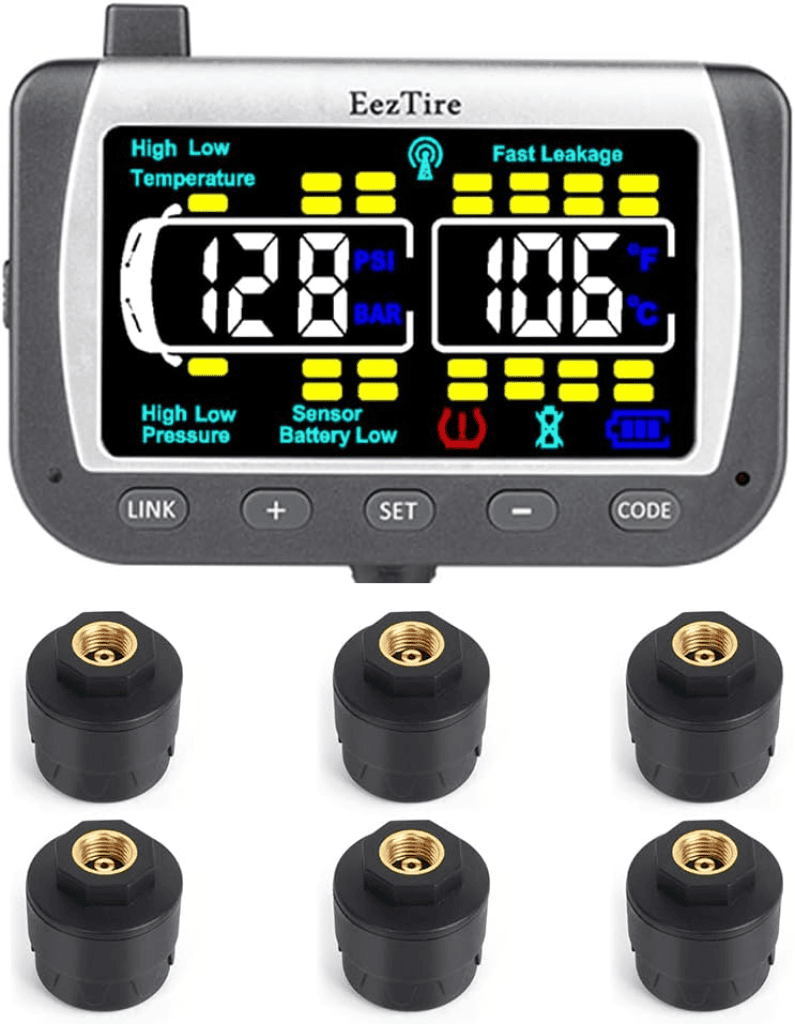
At a glance
| Model | EEZTire-TPMS6ATC |
| Real-Time Monitoring | Yes |
| Continuous Monitoring | 24×7 |
| Monitoring Sensors | 6 |
| Tire Pressure Range | 0 to 188 PSI |
| Temperature Range | -40°F to 176°F (-40°C to 80°C) |
| Display Unit | Included |
| Display Unit Power Source | 12V DC (Vehicle’s power) |
| Sensor Battery Life | Up to 2 years |
| Sensor Signal Transmission | Wireless (RF) |
| Sensor Installation | Screw-on |
| Tire Leak and High/Low Alert | Yes |
| Customizable Alerts | Yes |
| Certification | FCC, CE |
| Warranty | 3 Years |
Why we love it
The EEZTire-TPMS6ATC TPMS by EEZ RV Products is a a top-notch TPMS system designed specifically for RVs. This TPMS system can monitor tire pressure and temperature for up to 26 tires, with a maximum tire pressure handling capacity of 210 psi. This makes it suitable for a wide range of RV configurations, ensuring that all tires are constantly monitored for optimal safety.
The EEZTire TPMS system’s advanced technology alert system sets it apart from its competitors. The monitor is motion-sensitive and continuously monitors tire pressure and temperature at 6-second intervals. If the pressure or temperature falls outside the preset safety parameters, the system immediately sends visual and audio warning signals, providing timely alerts to the driver. Additionally, to conserve battery life, the monitor automatically goes into power-saving mode after 15 minutes of no motion detection. This thoughtful addition helps to extend the battery life of the monitor.
Operating and maintaining the EEZTire TPMS system is easy and straightforward. The system’s monitor features a display screen, measuring 4.5 inches by 3 inches, making it easy to read tire data. Setting up and programming the monitor is quick and simple, taking just minutes.
The monitor comes with a built-in rechargeable lithium battery that provides up to 60 hours of usage on a single charge. The sensors, on the other hand, have replaceable batteries, ensuring long-term functionality. The system also includes a USB charging cord that can be conveniently connected to the vehicle’s cigarette lighter or USB port.
The EEZTire TPMS system is a versatile and functional TPMS that can be customized to meet the needs of different users. The monitor has separate controls for RV and trailer sensors, and can be programmed with either anti-theft sensors or flow-through sensors, or a combination of both. A booster can also be added to enhance the signal strength of the system. The EEZTire TPMS system is backed by a 3-year limited warranty and offers technical and customer support.
2. TST 507 Tire Pressure Monitoring System
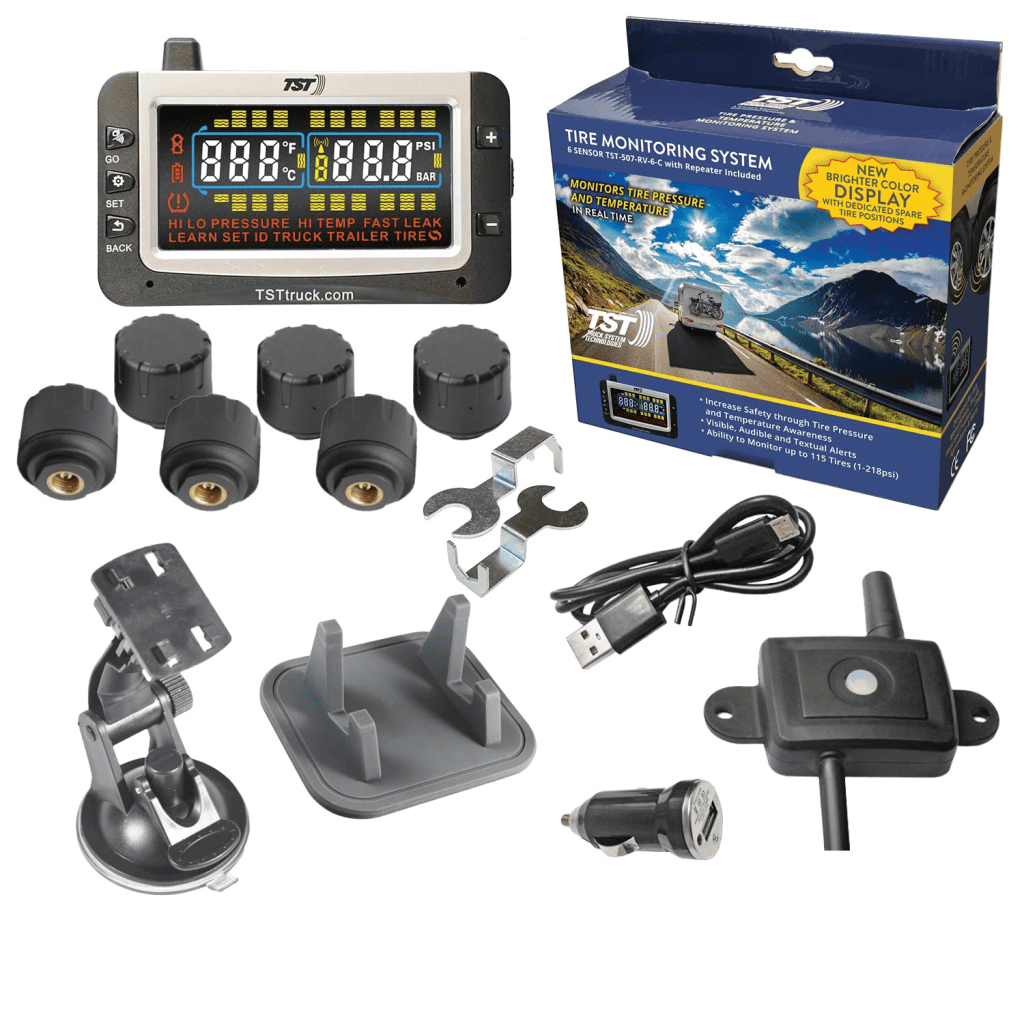
At a glance
| Model | TST 507 |
| Monitoring Sensors | 6 Cap Sensors |
| Real-Time Monitoring | Yes |
| Continuous Monitoring | Yes |
| Tire Pressure Range | 0 to 218 PSI |
| Temperature Range | -40°F to 257°F (-40°C to 125°C) |
| Display Unit | Color Display |
| Display Unit Power Source | 12V DC (Vehicle’s power) |
| Sensor Battery Life | Up to 2 years |
| Sensor Signal Transmission | Wireless (RF) |
| Sensor Installation | Screw-on |
| Tire Leak and High/Low Alert | Yes |
| Customizable Alerts | Yes |
| Certification | FCC, CE |
| Warranty | 3 Years |
Why we love it
Another great TPMS for RVs I would like to recommend is the TST 507 TPMS system. It features a color monitor screen that displays tire pressure and temperature in real time, along with visual, audible, and textual alerts to notify you when tire conditions reach unsafe levels. You can also choose your preferred unit of measurement, such as PSI or BAR, Fahrenheit or Celsius.
What sets the TST 507 system apart from the rest is its ability to monitor tire pressures between 0 and 218 PSI, making it suitable for a wide range of vehicles and applications. This makes it a great choice for RVs, as well as tow vehicles, boat trailers, and more.
The system uses wireless sensor technology for convenience and ease of installation. The cap-style sensors are lightweight, compact, and water-resistant, making them suitable for use in various climates and weather conditions. The sensors also have user-replaceable CR1632 batteries and an anti-theft feature.
Installing the TST 507 TPMS system is simple and straightforward. The kit comes with everything you need, including a color display, cap-style sensors, an installation wrench, a rubber display mount, a suction cup display mount, a USB charging cable, a 12V charging adapter, and a detailed user manual. The TST 507 TPMS system also offers a 3-year warranty and a 30-day return policy. This gives you peace of mind knowing that you are protected by the manufacturer’s confidence in their product.
3. GUTA GT107-2 RV Tire Pressure Monitoring System
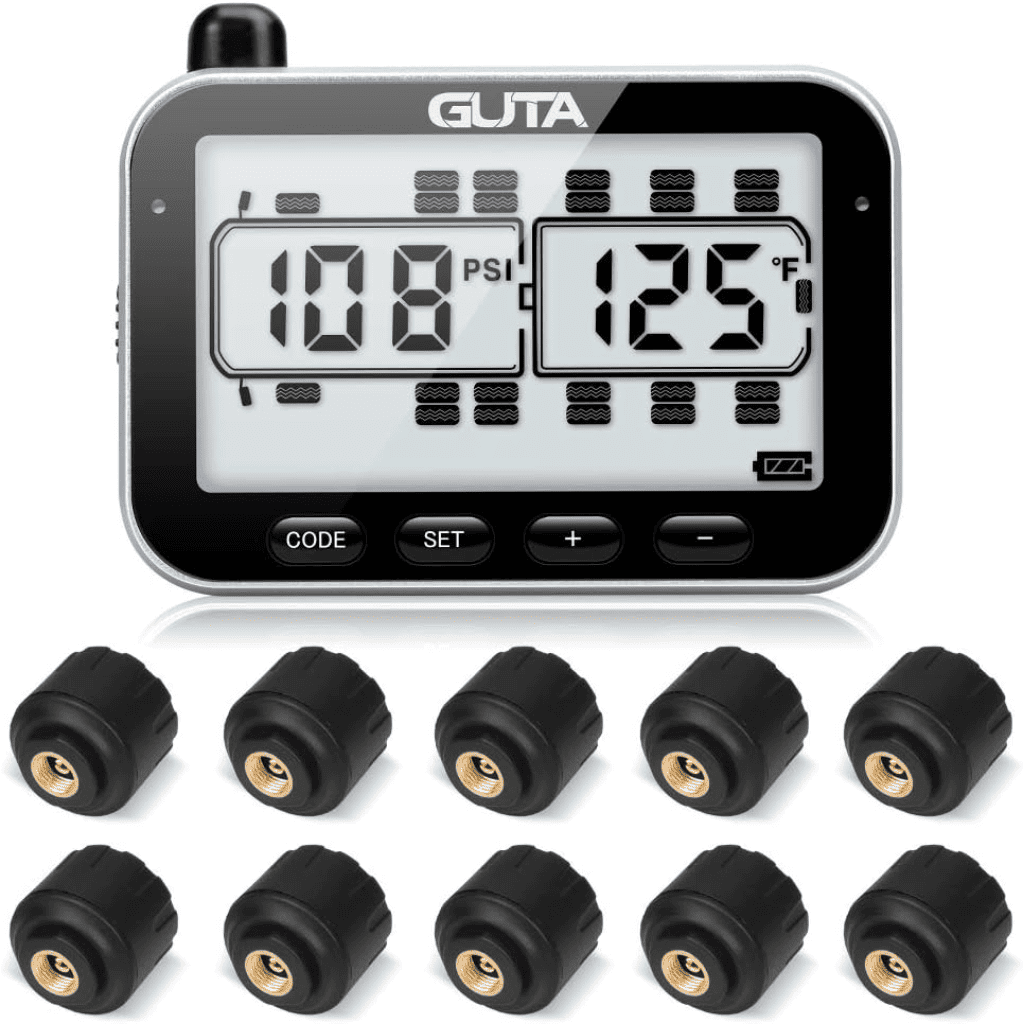
At a glance
| Model | Guta GT107-2 Series |
| Monitoring Sensors | 10 Sensors |
| Real-Time Monitoring | Yes |
| Continuous Monitoring | Yes |
| Tire Pressure Range | 0 to 188 PSI |
| Temperature Range | -4°F to 185°F (-20°C to 85°C) |
| Display Unit | LCD |
| Sensor Battery Life | Up to 14 days |
| Sensor Signal Transmission | Wireless (RF) |
| Tire Leak and High/Low Alert | Yes |
| Customizable Alerts | 7 Alert Modes |
| Sensing Distance | 80 feet |
| Warranty | 2 Years |
Why we love it
The GUTA GT107-2 Series TPMS is a perfect tire pressure monitoring system for RV enthusiasts who want a quality product without breaking the bank. One of the things that sets this TPMS apart is its repeater, which extends the sensing range up to an impressive 80 feet. This means you can get real-time updates on tire pressure and temperature from anywhere in your RV, even if the sensors are located in the back. This is a major advantage over other TPMS systems, which often have a limited sensing range.
The GUTA TPMS’s generously-sized LCD screen is a standout feature. It seamlessly integrates an energy-saving design, resulting in a remarkable battery life of up to 14 days. This means you can monitor your tire pressure and temperature for extended periods of time without having to worry about the battery running out.
With the large screen, it can display tire pressure and temperature for up to 24 tires simultaneously. You can also choose to view the readings in either degrees Fahrenheit or Celsius for temperature and PSI or BAR for pressure. These dual readings give you a holistic understanding of your tire conditions, so you can be sure that your tires are properly inflated and in good condition.
With the GUTA TPMS, you can say goodbye to charging anxiety. It only takes a quick 4-hour charge to keep it running for your entire journey. And with its wide monitoring range of 0-188 PSI for tire pressure and -4~185 ℉ for temperature, the GUTA TPMS can handle any RV setup.
Another standout feature of the GUTA TPMS is its precise alerts. The system is customizable to activate an alarm whenever tire pressure deviates by 25% from the preset value. This ensures that you’re only alerted to real problems, not false alarms. And with seven different alarm modes, you’ll be kept informed of everything from low/high tire pressure to temperature variations, low battery status, fast leaks, and signal loss.
4. TireMinder Solar Powered Trailer TPMS
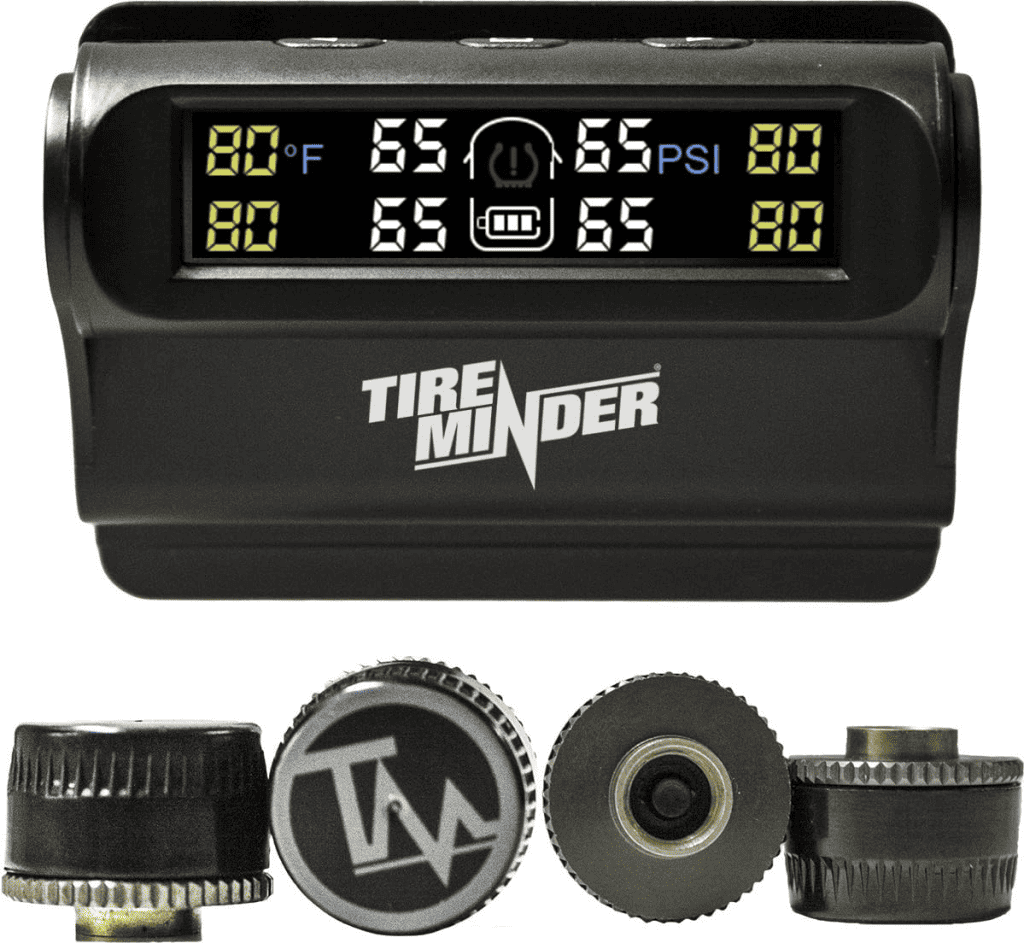
At a glance
| Model | TPMS-TRAILER |
| Monitoring Sensors | 4 |
| Real-Time Monitoring | Yes |
| Continuous Monitoring | Yes |
| Tire Pressure Range | 0 to 70 PSI |
| Display Unit | Crystal Clear LCD Color Display |
| Display Unit Power Source | Highly Efficient Monocrystalline Solar Panel with Lithium Iron Phosphate (LiFePO4) Backup Battery |
| Sensor Battery Life | Replaceable CR1632 Batteries |
| Sensor Signal Transmission | Wireless (RF) |
| Sensor Installation | Universal Fit |
| Included Accessories | Windshield Mountable Monitor, Micro USB Charging Cable, Transmitter Batteries |
| Warranty | 3 Years |
Why we love it
The TireMinder Trailer TPMS offers great value for the money. It’s a solar-powered tire pressure monitoring system that’s designed for trailers 25 feet or less in length with tire pressure of 70 PSI or less. However, I used it on my 30 feet RV and it worked perfectly.
One of the standout features of the TireMinder Solar TPMS is its signal booster. This signal booster extends the range and reliability of the signal, so you can monitor your trailer’s tire pressure from even further away.
What sets this TPMS apart is its use of a monocrystalline solar panel in the monitor. In addition to the solar panel, the TireMinder Trailer TPMS also has a long-lasting lithium iron phosphate battery. This battery is designed to last for years, even with regular use. So you can be confident that your TireMinder Trailer Solar TPMS will always be up and running, no matter how long you’re on the road.
And if you ever do find yourself in a situation where the solar panel isn’t getting enough sunlight, the TireMinder Trailer TPMS also comes with a power cord so you can plug it into your vehicle’s cigarette lighter. This gives you peace of mind knowing that your TPMS will always be operational, no matter what.
The TPMS features a clear and easy-to-read color LCD display that shows tire pressure and temperature readings for all four tires. It can be mounted in the windshield of your RV for convenient viewing. With its ability to monitor four tires simultaneously, this TPMS is a great choice for small to mid-sized trailer owners.
5. VESAFE RV-4E09 Wireless TPMS for RV
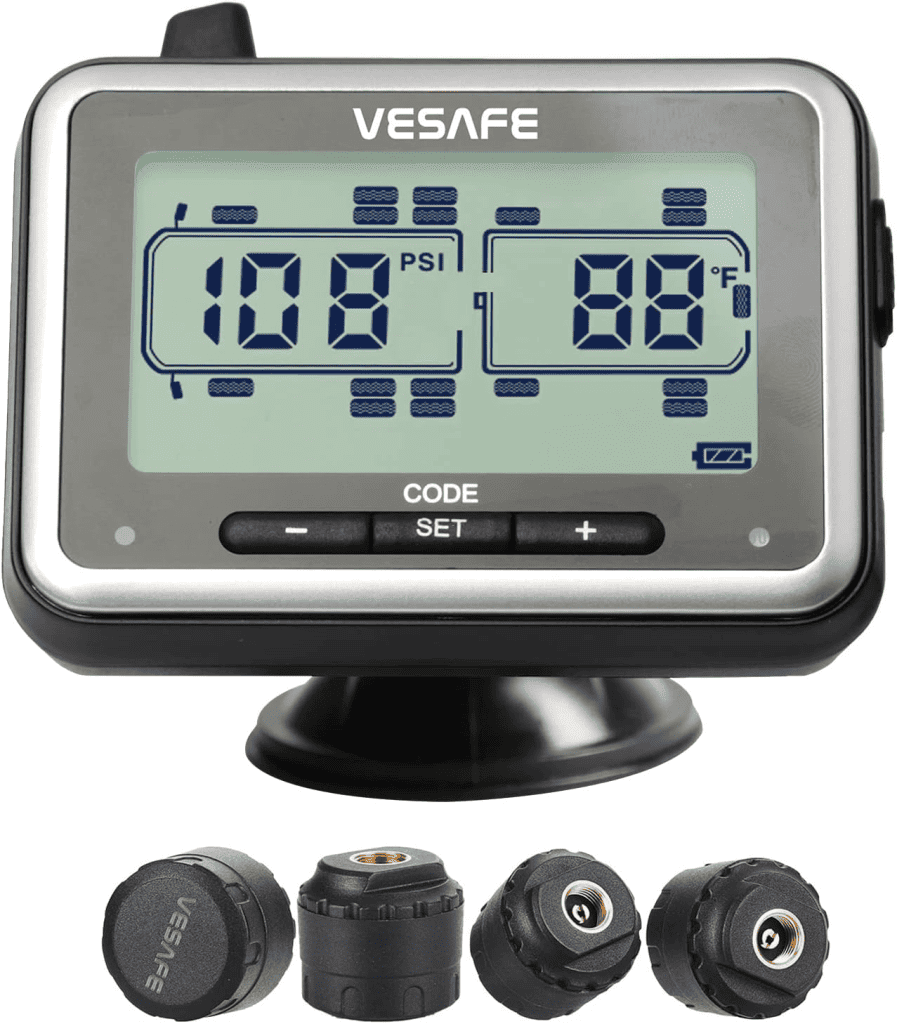
At a glance
| Model | RV-4E09 |
| Monitoring Sensors | 4 |
| Real-Time Monitoring | Yes |
| Continuous Monitoring | Yes |
| Display Unit | Large Screen |
| Sensor Battery Life | Up to 2 years |
| Sensor Signal Transmission | Wireless (RF) |
| Sensor Installation | Anti-Theft and Durable |
| Customizable Alerts | Alert Values Adjustable |
| Replaceable Batteries | Yes |
| Warranty | 18 Months |
Why we love it
The VESAFE RV-4E09 Wireless TPMS is another reliable solution that provides consistent tire pressure monitoring for big rigs. It can monitor the tire conditions of up to 17 tires in total, and has a long transmitting range of up to 50 feet. This means that the sensors can be placed on the tires of a large vehicle, and the monitor can be placed in the cab of the vehicle, without any signal loss.
The TPMS comes with five alarm modes, and users can adjust the alert values based on their specific needs. Whenever a tire pressure is outside of the preset range, an alarm will be triggered to notify RV drivers of potential tire issues. This early warning can help prevent accidents on the road.
The large screen of the tire pressure monitor displays real-time data for each tire. It scrolls through the connected tires every 5 seconds, so you can quickly identify any abnormal tire conditions. If there are any irregularities, both audible and visible warnings are triggered, alerting the driver to take immediate action.
The VESAFE RV-4E09 TPMS is also very energy-efficient and has a long lifespan. The monitor has a built-in lithium-ion rechargeable battery that can last up to 5,000 miles on a single charge. This means you can go for long road trips without having to worry about the monitor running out of power. The tire sensors are also built to last. They are equipped with a battery that can last for years. Once the batteries need to be replaced, they can be easily swapped out, so you don’t have to buy a new sensor.
The TPMS also features automatic connection and sleep modes for added convenience. The monitor automatically enters sleep mode when not in use, and wakes up when it senses movement or when you tap the screen. If you are towing a trailer, the TPMS will automatically connect and disconnect to the trailer based on distance. This eliminates the need to manually pair the TPMS with the trailer.
The sensors are designed with an anti-theft function and can be securely mounted to the tires using a hex nut and wrench. These sensors are also waterproof and dust-proof, thanks to the O-rings that protect them. This makes them resilient to various weather conditions and environmental damage.
Choosing Tire Pressure Monitoring System for RV: Buying Criteria
With so many TPMS options available, it’s important to consider your needs and budget before making a selection. A reliable TPMS can help you maintain proper tire inflation, provide real-time monitoring, and alert you to potential problems. It can also enhance the overall performance and longevity of your tires.
Let’s explore the key factors to consider when choosing the best TPMS for your RV:
Display
When looking for the best RV tire pressure monitoring system (TPMS), think about the display. Choose a display that is easy to read and provides clear information about tire pressure and temperature. A backlit display is helpful for nighttime visibility. Make sure that the display can be conveniently mounted or placed within your RV’s cabin for optimal visibility and accessibility while driving.
LED displays are commonly used in RV TPMS systems because they are clear, visible, and energy-efficient. LED displays offer bright, high-contrast visuals that are easy to read in different lighting conditions. They can provide clear numeric readings of tire pressure values and may also incorporate visual indicators such as color-coded alerts or icons to signify different tire conditions.
LED displays are resistant to vibrations and can withstand temperature fluctuations, making them ideal for the rugged environments encountered during RV travel. They also offer bright, high-contrast visuals that are easy to read in different lighting conditions.
In addition to LED displays, some RV TPMS systems may also feature LCD (liquid crystal display) screens. LCD screens can offer similar clarity and visibility, but they may have slightly different characteristics, such as lower power consumption or different viewing angles. LCD displays can provide clear tire pressure information, although they may have different contrast ratios or refresh rates compared to LED displays.
Ultimately, the best display type for your RV TPMS will depend on your individual needs and preferences. If you are looking for a durable and reliable display that is easy to read in different lighting conditions, then an LED display is a good choice. If you are looking for a display that is energy-efficient or has specific viewing angle requirements, then an LCD display may be a better option.
Durability
Durability is another crucial factor to consider when choosing an RV TPMS. The average lifespan of a TPMS system is 7-10 years, but some systems can last longer with proper care.
While it’s true that more expensive TPMS systems tend to be more durable, there are also durable options available at reasonable prices. When choosing a TPMS, it is important to consider the quality of the components, the materials, as well as the brand’s reputation.
- The quality of the sensors: The sensors are the most important components of a TPMS system, as they are responsible for measuring the tire pressure. High-quality sensors are made from durable materials and are resistant to water, dust, and extreme temperatures.
- The construction of the system: The overall construction of the TPMS system also affects its durability. Systems that are made from high-quality materials and are well-made will last longer.
- The brand’s reputation: The brand’s reputation is also a good indicator of the durability of the TPMS system. Brands that have a good reputation for quality and reliability are more likely to produce durable systems.
Easy Installation
When choosing an RV TPMS, you should also consider how easy it is to install. Some systems require professional installation, while others can be installed by the average DIYer. Think about your comfort level with DIY projects and your skills with tools. It’s recommended to look for systems that come with clear instructions, all the necessary mounting hardware, and a user-friendly installation process.

Accuracy
Accuracy is key for effective tire monitoring. Look for TPMS systems that offer precise measurements and individual tire pressure readings. Accuracy can have a significant impact on performance and convenience, so it’s important to choose a TPMS that is known for reliable and consistent readings.
Indirect TPMS can provide some level of tire pressure monitoring, but it is generally less accurate than direct TPMS. Direct TPMS offers the advantage of individual tire pressure readings, which allows for more precise monitoring and timely detection of any deviations. This accuracy can be especially valuable for RVs, where tire maintenance and safety are crucial during long trips or while carrying heavy loads.
Ultimately, if accuracy is a top priority for you, a direct TPMS system for your RV would be the best choice. Direct TPMS systems offer the most precise and reliable tire pressure readings, which can help you keep your RV safe and on the road.
Sensor Battery
TPMS sensors are powered by a small, built-in battery, similar to those found in vehicle key fobs. TPMS sensors can be classified into two types based on their batteries: replaceable and non-replaceable.
- Non-replaceable batteries: These batteries are typically used in indirect TPMS systems and are not designed to be replaced. When the battery dies, the entire sensor must be replaced. The average lifespan of a non-replaceable TPMS battery is 7 years.
- Replaceable batteries: These batteries are typically used in direct TPMS systems and can be replaced by the user. This makes them a more sustainable option, as they can be replaced without having to replace the entire sensor. The lifespan of a replaceable TPMS battery varies depending on the make and model, but it is typically around 5 years.
When choosing a TPMS for your RV, it is important to consider the type of battery used. If you prefer a more sustainable option, then a TPMS with replaceable batteries is a good choice. However, if you want a system that is less expensive to maintain, then a TPMS with non-replaceable batteries may be a better option.
It is also important to check the battery life warranty when choosing a TPMS. Some manufacturers offer a longer warranty on their batteries, which can give you peace of mind knowing that you will be covered if the battery dies prematurely.
Finally, be sure to ask the manufacturer about the battery life indicator or low-battery alert features. These features can help you to ensure that your TPMS system is always functioning properly.
Additional Features
Consider additional features that can enhance the functionality of your TPMS.
Tire temperature monitoring can help you detect overheating issues, which can lead to tire failure.
Customizable pressure thresholds allow you to set personalized alerts based on your RV’s tire requirements. This can help you ensure that you are alerted to even small changes in tire pressure, which can help you prevent tire problems.
Wireless connectivity to mobile devices enables remote monitoring, so you can check your tire pressure and temperature from anywhere. This can be especially helpful if you are traveling and cannot always be near your RV.
Assess your specific needs and preferences to determine which features are essential for your TPMS. For example, if you often travel in hot climates, tire temperature monitoring may be a more important feature for you.
Budget
When choosing a TPMS system, it is important to consider your needs and budget. TPMS systems can range in price depending on their features, quality, and brand. Consider the features that are most important to you and find a balance between affordability and functionality.
Remember that investing in a reliable and high-quality TPMS is essential for safety and tire maintenance, so I recommend prioritizing quality over the lowest price.
TPMS systems typically range in price from $50 to $600, depending on the features they offer.
- Basic TPMS systems provide essential tire pressure monitoring without extensive additional features. They are often the most affordable option, starting at around $50.
- Mid-range TPMS systems offer a balance between affordability and additional features. They may include features such as temperature monitoring, adjustable pressure thresholds, and wireless connectivity. These systems typically cost between $150 and $300.
- Advanced TPMS systems offer the most features and functionality. They typically include individual tire pressure and temperature readings, customizable alarms, multiple display options, and smartphone integration. These systems can cost upwards of $300.
Who Makes The Best RV Tire Pressure Monitoring Systems?
When it comes to choosing the best TPMS for your RV, there are several reputable brands that offer high-quality products. Here are a few of the top TPMS brands to consider:
- TST (Truck System Technologies): TST is a well-known manufacturer of TPMS systems specifically designed for RVs and trucks. Their products are praised for their accuracy, reliability, and user-friendly features.
- EEZTire: EEZTire is another popular brand that specializes in RV TPMS systems. Their products are highly regarded for their ease of installation, accurate monitoring, and durable construction.
- TireMinder: TireMinder offers a range of TPMS systems designed for RVs, trailers, and trucks. Their systems are known for their advanced features, such as solar-powered monitors and long-lasting battery life.
In addition to the widely recognized brands mentioned above, there are a few other companies that offer TPMS for RVs with good quality at affordable prices. These include:
- GUTA: GUTA offers a range of TPMS systems, including models designed for RVs. Their systems typically feature wireless sensors that transmit tire pressure data to a central monitor. GUTA TPMS systems are known for their affordability and basic functionality.
- VESAFE: VESAFE is another brand that provides wireless TPMS systems for RVs. Their products often include features such as adjustable alarm values for tire pressure, temperature, leakage, and battery life. VESAFE TPMS systems typically have a large screen that displays real-time tire data and triggers audible and visible warnings for abnormal conditions. They are also known for their low power consumption and long battery life.
How to Install an RV Tire Pressure Monitoring System
When installing an RV tire pressure monitoring system, there are a few key steps to follow. By following these instructions, you can ensure a smooth and successful installation process and optimize the functionality and effectiveness of your TPMS.
Selecting the right TPMS: The first step is to choose the right TPMS for your RV. Consider factors such as the number of sensors you need, the monitoring capabilities you want, and the compatibility of the TPMS with your RV.
Preparing the sensors: Before you install the sensors, you need to prepare them for use. This may involve activating the sensors, inserting batteries, and ensuring that they are ready to pair with the TPMS monitor.
Identifying tire positions: Take the time to identify the exact tire positions where you want to install the TPMS sensors. This includes both the tires on your RV and any towed vehicles.
Installing the sensors: Once you have prepared the sensors and identified the tire positions, you can install the sensors securely onto the valve stems of each tire. Follow the manufacturer’s instructions for the correct installation technique, which may involve using wrenches or tools provided with the TPMS.
Mounting the TPMS monitor: Decide on the best place to mount the TPMS monitor inside your RV. Common options include the dashboard or windshield for easy viewing. Use the mounting accessories provided, such as suction cups or adhesive strips, to ensure a secure and stable attachment.
Powering the monitor: Connect the TPMS monitor to a power source according to the manufacturer’s instructions. This typically involves using a power adapter or plugging it into a cigarette lighter or USB port. Make sure the monitor has enough power to function properly.
Pairing the sensors: Begin the pairing process between the TPMS monitor and the installed sensors. Follow the manufacturer’s specific instructions to establish a successful connection and enable accurate data transmission.
Testing the system: After completing the installation, it is critical to conduct a thorough test to ensure that the TPMS is operating properly. Verify that the monitor displays accurate tire pressure and temperature readings, and that it promptly alerts you to any unusual circumstances or potential issues.
FAQs about TPMS for RV
How long do RV tire pressure monitoring systems last?
The lifespan of an RV tire pressure monitoring system typically ranges from 3 to 7 years, depending on factors such as brand, usage, maintenance, and component quality. The monitor/display unit can last several years, while the wireless sensors usually have a battery life of 1 to 2 years. Following manufacturer guidelines, conducting regular maintenance, and replacing worn-out components will help maximize the TPMS’s lifespan and ensure accurate tire pressure monitoring.
Can tire pressure sensors be replaced?
Yes, tire pressure sensors can be replaced. If a tire pressure sensor becomes faulty or its battery life is depleted, it can be removed and replaced with a new sensor. This is especially common with tire pressure monitoring systems that use wireless sensors. It’s important to ensure compatibility between the new sensor and the TPMS system to ensure proper functionality. Some sensors may require programming or syncing with the TPMS system after replacement.
How many sensors for TPMS do you need?
The number of sensors required for a TPMS system depends on the number of tires you want to monitor. Typically, for a standard vehicle with four wheels, you will need four sensors—one for each tire. However, for larger vehicles like RVs or trailers with multiple axles, you may need additional sensors to monitor all the tires effectively. It’s essential to ensure that you have enough sensors to cover all the tires you want to monitor accurately.
Where are the TPMS sensors located?
TPMS sensors are typically located inside each tire, near the valve stem. They are attached to the rim or integrated with the valve stem itself. The sensors continuously monitor the tire pressure and transmit the data wirelessly to the TPMS receiver/display unit inside the vehicle. Some vehicles may also have the TPMS sensors integrated into the tire’s air valve assembly. The exact location may vary slightly depending on the vehicle make and model.
What happens when a TPMS sensor battery dies?
When a TPMS sensor battery dies, the sensor will no longer transmit tire pressure and temperature data to the TPMS display unit. As a result, the TPMS will no longer be able to provide real-time monitoring of tire conditions for the affected tire. The TPMS display may show an alert or warning indicating a sensor battery failure. To restore the functionality of the TPMS, the dead sensor battery needs to be replaced. It is important to regularly check the battery life of TPMS sensors and replace them as needed to ensure accurate tire pressure monitoring and overall safety on the road.
What should my RV tire pressure be?
The recommended tire pressure for your RV can vary depending on the specific make and model of your vehicle, as well as the type and size of tires being used. It is important to refer to the manufacturer’s guidelines or consult your RV owner’s manual for the correct tire pressure specifications. The recommended tire pressure is typically provided by the vehicle manufacturer based on factors such as load capacity, tire size, and driving conditions. It is crucial to maintain proper tire pressure to ensure safe and efficient RV operation, as well as to maximize tire life and fuel economy.
